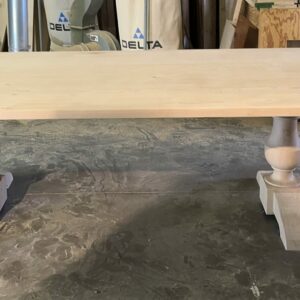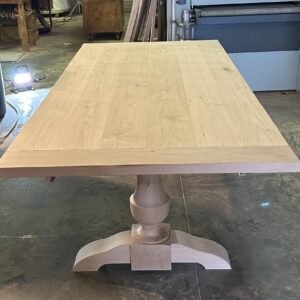Good morning, fellas. So I am a wood guy but I do very little of my own finishing (typically just do high-end staircases and handrails). I built a table for my wife out of alder and am going to distress and stain it using general finishes gel stain (2 parts antique walnut, 1 part ash grey, and some black transtint dye), but I am nervous about how the round pedestal bases are going to accept stain. I have had a difficult time controlling the blotch on the samples, but I have settle on a finish sanding job of 180 grit. My turner has the bases sanded pretty fine so I’m not sure that I want to sand them more, but I’m wondering if I should sand them finer than the 180 on the table since there will be a fair bit of endgrain. Any suggestions would be helpful!
Discussion Forum
Get It All!
UNLIMITED Membership is like taking a master class in woodworking for less than $10 a month.
Start Your Free TrialDiscussion Forum
Digital Plans Library
Member exclusive! – Plans for everyone – from beginners to experts – right at your fingertips.
Highlights
-
Shape Your Skills
when you sign up for our emails
This site is protected by reCAPTCHA and the Google Privacy Policy and Terms of Service apply. -
 Shop Talk Live Podcast
Shop Talk Live Podcast -
 Our favorite articles and videos
Our favorite articles and videos -
E-Learning Courses from Fine Woodworking
-
-
 Fine Woodworking New England Event
Fine Woodworking New England Event














Replies
I'm no help at all with staining recommendations, but I just gotta say, I think that's a beautiful table. Nicely done, sir, nicely done.
Haha. Thanks! I'm sure this is a no surprise...but it took much longer than I had planned. Since it is an extension table and is pretty heavily distressed (not visible in the photos) it was a lot of work to get the distressing to look correct with both the leaves or out. I'm happy the table is built...just not looking forward to possibly ruining it with a mediocre stain job **sigh**...
My understanding is that alder behaves much like cherry. I don't know if that includes it's propensity to blotch or not. However, I have had good results using danish oil on cherry prior to gel stain. I apply the danish oil and let it dry for only about 8 hours then apply the gel stain. It appears that by allowing only 8 hours, the gel stain can blend a bit better. If I allow the oil to completely cure, the wood will not take the stain as well and it will end up a lighter color.. But, either way, it does control the blotch quite well. However, with this process, you may have to adjust your stain formula somewhat. Experiment on some scrap.
Also, you might get better results using a dye like Transtint or similar. I usually start with a medium or light brown and then add primary colors a drop at a time until I get the color I want. Again, experiment on scrap. Keep in mind that once the dye dries on/in the wood, it won't display it's final color until you put a clear coating over it. When experimenting, use a spray can of clear lacquer or poly.
I never worked with alder but reading a little on it it appears to be a soft wood with closed cells so I would expect that the wood will not absorb gel stain like a mahogany would but more like pine. Gel stain on woods of this type will be controlled by the sanding patern, in other words, the finer the sanding the lighter the color will be after wiping the stain. The turnings probably have been sanded cross grain on the lathe so will retain stain in a different way so you will need to experiment on samples to match the color between different parts using different sandpaper grits, sanding finer than 120-150 grit will often have the gel stain just be wiped away so test it first.
I generally go up a grit or two for end grain when trying to match face / edge grain. This can also be controlled by using a sealer or a finish that is closer to a paint due to high pigment content.
The answer to most finish questions is answered with a test board. Take a scrap of each board type, surface prep (sand in your case) them as the others were prepared and test. This is the best way to know exactly what is going to happen when you do the same finishing steps to your very nice table.
Thank for the responses! I ended up sanding the endgrain with 220 and everything else with 180. The endgrain still stained a little darker than the rest but not much. My biggest concern was with the round pedestal since I could not practice on a large turning such as that, but they turned out well. I will post pics when I put the table back together.
This forum post is now archived. Commenting has been disabled